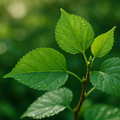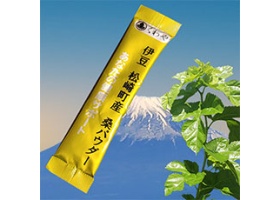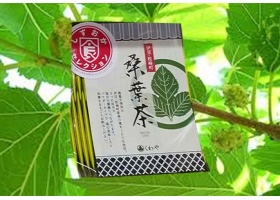Kuwa Leaf Basics

About Us
There are two sides to this story: the story of Matsuzaki Kuwa Farm and the story of myself, Jim Parker. Together, they have come to form one path.
Matsuzaki is a small town on the western coast of the Izu Peninsula. Unlike most coastal towns in the region, which are built around fishing, Matsuzaki, for the most part, has always been rooted in agriculture. Two rivers cut through the town, nourishing fields of rice, vegetables, and, most importantly for this story, mulberry (kuwa).
For many years, Matsuzaki was far more isolated than its closeness to Tokyo might suggest. Until about 1953, when the first coastal road was built, transportation was limited to ships or long footpaths over the mountains to reach the rail lines of the eastern peninsula.
And yet, Matsuzaki thrived. It was an early leader in education, establishing one of Japan’s first Western-style schools in 1880. Built at what would equal tens of millions of yen today, this investment was extraordinary for a rural community. But Matsuzaki’s people were forward-thinking, willing to invest heavily in the future of their children.
The town’s prosperity came from three products shipped to Tokyo: quarried stone, charcoal, and mulberry leaves for silk production. Over time, stone lost its demand, charcoal gave way to electricity and petroleum, and silk was replaced by synthetics. Matsuzaki’s fortunes declined, its population shrinking from 12,000 in 1960 to about 6,000 today, while the average age has risen to well over fifty.
Still, history has a way of circling back. Just as the town once invested in education, today it has turned again to its roots, drawing on its land, its knowledge, and its culture to revive the mulberry—not for silk this time, but for health. The cultivation of mulberry and the production of kuwa powder have become both a symbol of renewal for the town and a product of growing importance to the wider world.
And at the center of this revival stands Mr. Takahashi, the Matsuzaki entreprenuer, that I would later meet in a small shop in Matsuzaki. It was through him, and through the people of Matsuzaki Kuwa Farm, that I became a part of this story.
The Story of Kuwa
In the quiet coastal village of Matsuzaki, Japan, families have worked the land and sea for generations. But like so many rural communities around the world, Matsuzaki faces a challenge: how to keep its young people from leaving for the city in search of opportunity. Without new ideas and sustainable work, the rhythm of rural life risks fading away.
The story of Kuwa begins with a small group of residents—farmers, fishermen, and even professionals who once worked city jobs—coming together to look for a way forward. Their goal was simple but vital: create meaningful employment, protect the village way of life, and connect their heritage to something of value for the modern world. Their answer lay in a tree with deep roots in Japanese history—the Kuwa, or white mulberry tree.
A Tree with History
For centuries, the Kuwa tree has played an essential role in Japanese culture. Its leaves are the sole food of silkworms, which spin the cocoons used to produce silk—once one of the most prized fabrics in the world. In Japan, generations of farmers carefully cultivated mulberry trees to ensure their leaves were of the highest quality, giving rise to silk renowned for its strength and beauty. This tradition shaped not just the economy but the very identity of many rural regions.
But with the invention of nylon and other petroleum-based fabrics in the 20th century, the silk industry declined. Mulberry groves that once sustained entire communities fell silent. Yet, while the demand for silk faded, the Kuwa tree itself remained—a resource waiting to be rediscovered.
From Tradition to Innovation
The people of Matsuzaki saw in the Kuwa tree not just history, but possibility. Scientific research has shown that its leaves carry remarkable health benefits, supporting balanced blood sugar, digestion, and overall wellness. By harvesting, drying, and processing these leaves into a natural powder, the community found a way to turn a centuries-old tradition into a modern health supplement.
Today, Kuwa is more than a product—it is a movement to sustain local life. Each package of Kuwa powder represents the hard work of farmers, the care of harvesters, and the hope of a village determined to thrive. It is a bridge between past and present, heritage and innovation, Japan and the wider world.
A Universal Challenge
What is happening in Matsuzaki is not unique to Japan. Across the globe, rural towns face the same struggle: preserving their traditions while providing opportunities that inspire younger generations to stay. Kuwa stands as an example of what can be achieved when communities look inward to their history, their land, and their shared creativity for solutions.
By choosing Kuwa, you are not only embracing a natural path to health—you are also helping to keep a community alive, connected, and full of purpose.
--- Would you like me to also draft a **shorter “marketing version”** of this (around 150–200 words), which you could use for landing pages or promotional materials, alongside this fuller story?
 For over 5,000 years mankind has been cultivating the mulberry tree. First discovered by a Chinese princess, its cultivation was protected by the threat of death. The history of the mulberry and its relationship with the silkworm is one of intrigue, romance, and business.
For over 5,000 years mankind has been cultivating the mulberry tree. First discovered by a Chinese princess, its cultivation was protected by the threat of death. The history of the mulberry and its relationship with the silkworm is one of intrigue, romance, and business.
- Suppress Blood Sugar Without Drugs: Life Extension Magazine
- Mulberry Leaf Improves Glucose Tolerance
- Effects of Mulberry Leaf on Blood Lipid
- Influence of Mulberry Leaf Extract on the Blood Glucose American Diabetes Association
- Food-grade mulberry powder enriched with 1-deoxynojirimycin suppresses the elevation of postprandial blood glucose in humans
- Development of Mulberry Leaf Product with α-Glucosidase Inhibitor for the Prevention of Type2 Diabetes Mellitus
- Development of glucose level rise control mulberry leaf product using 1-deoxynojirimycin
- Impact of Mulberry Leaf on Type 2 diabetes – University of Mississippi
- Mulberry (Morus Alba L.) Leaves – Journal of Nutrition
- Mulberry Extract may prevent diabetes – study
- Mulberry Leaf Extract Inhibits the Oxidative Modification and Low Density Lipoprotein
- Mulberry Leaf Extract Promotes Weight Control
- Effect of mulberry leaf extract with enriched 1-deoxynojirimycin content on postprandial glycemic control in subjects with impaired glucose metabolism
- Scientific Research / Super Foods – Mulberry Benefits and Medical Effect
- Cancer’s Sweet Tooth
- Comprehensive Research on Effects of Substance Abuse and Diabetes
The Journal of Agricultural and Food Chemistry published findings that mulberry leaf extract may help prevent some forms of diabetes by suppressing insulin production when taken regularly and in conjunction with other healthful practices
Fratkin J, Fischer W, Wu Y. Practical Therapeutics of Traditional Chinese Medicine. Brookline, MA: Paradigm Publications, 1997.
Hirayama C, Sugimura M, Saito H, et al. Purification and properties of urease from the leaf of mulberry, morus alba. Phytochemistry February;53(3):325-30.
Murata K, Yatsunami K, Fukuda E, et al. Antihyperglycemic effects of propolis mixed with mulberry leaf extract on patients with type 2 diabetes. Altern Ther Health Med May-June 2004;10(3):78-9.
Ratanapo S, Ngamjunyaporn W, Chulavatnatol M. Interaction of a mulberry leaf lectin with a phytopathogenic bacterium, P. syringae pv mori. Plant Sci March 2001;160(4):739-744.
Srivastava S, Kapoor R, Thathola A, et al. Mulberry (morus alba) leaves as human food: a new dimension of sericulture. Int J Food Sci Nutr November 2003;54(6):411-6.
Additional Research Studies:
Mulberry Leaf as Human Food
Srivastava S, Kapoor R, Thathola A, Sriyastaya RP. Mulberry (Morus alba) leaves as human food: a new dimension of sericulture. Int J Food Sci Nutr. 2003 Nov;54(4):411–6.
Mulberry Leaves as Antioxidants and Neuroprotective Agents
- Niidome T, Takahashi K, Goto Y, Goh S, Tanaka N, Kamei K, et al. Mulberry leaf extract prevents amyloid beta-peptide fibril formation and neurotoxicity. Neuroreport. 2007 May 28;18(8):813–6.
- Kang TH, Oh HR, Jung SM, Ryu JH, Park MW, Park YK, Kim SY. Enhancement of neuroprotection of mulberry leaves (Morus alba L.) prepared by the anaerobic treatment against ischemic damage. Biol Pharm Bull. 2006 Feb;29(2):270–4.
- Tewari RK, Kumar P, Sharma PN. Antioxidant responses to enhanced generation of superoxide anion radical and hydrogen peroxide in the copper-stressed mulberry plants. Planta 2006 May;223(6):1145–53. Epub 2005 Nov 15.
- Choi EM, Hwang JK. Effects of Morus alba leaf extract on the production of nitric oxide, prostaglandin E2 and cytokines in RAW264.7 macrophages. Fitoterapia. 2005 Dec;76(7-8):608–13. Epub 2005 Oct 17.
- Sharma R, Sharma A, Shono T, Takasugi M, Shirata A, Fujimora T, Machii H. Mulberry moracins: scavengers of UV stress-generated free radicals. Biosci Biotechnol Biochem. 2001 Jun;65(6):1402–5.
Mulberry Leaf in Lowering Lipidemia and Improving Blood Vessel Health
- Chen J, Li X. Hypolipidemic effect of flavonoids from mulberry leaves in triton WR-1339 induced hyperlipidemic mice.Asia Pac J Clin Nutr. 2007;16 Suppl 1:290–4.
- Harauma A, Murayama T, Ikeyama K, Sano H, Arai H, Takano R, et al. Mulberry leaf powder prevents atherosclerosis in apolipoprotein E-deficient mice. Biochem Biophys
- Res Commun. 2007 Jul 6;358(3):751–6. Epub 2007 May 7.
- Enkhmaa B, Shiwaku K, Katsube T, Kitajima K, Anuurad E, Yamasaki M, Yamane Y.Mulberry (Morus alba L.) leaves and their major flavonol quercetin 3-(6-malonylglucoside) attenuate atherosclerotic lesion development in LDL receptor-deficient mice. J Nutr. 2005 Apr;135(4):729–34.
- Doi K, Kojima T. and Fujimoto Y. Mulberry leaf extract inhibits the oxidative modification of rabbit and human low density lipoprotein. Bio Pharm Bull. 2000 Sep;23(9):1066–71.
Mulberry Leaf and Blood Sugar Management
- Kimura T, Nakagawa K, Kubota H, Kojima Y, Goto Y, Yamagishi K, et al. Food-grade mulberry powder enriched with 1-deoxynojirimycin suppresses the elevation of postprandial blood glucose in humans. J Agric Food Chem. 2007 Jul 11;55(14):5869–74. Epub 2007 Jun 8.
- Mudra M, Ercan-Fang N, Zhong L, Furne J, Levitt M. Influence of mulberry leaf extract on the blood glucose and breath hydrogen response to ingestion of 75 g sucrose by type 2 diabetic and control subjects. Diabetes Care. 2007 May;30(5):1272–4. Epub 2007 Feb 15.
- Hansawasdi C, Kawabata J. Alpha-glucosidase inhibitory effect of mulberry (Morus alba) leaves on Caco-2. Fitoterapia. 2006 Dec;77(7-8):568–73. Epub 2006 Sep 22.
- Oku T, Yamada M, Nakamura M, Sadamori N, Nakamura S. Inhibitory effects of extractives from leaves of Morus alba on human and rat small intestinal disaccharidase activity. Br J Nutr. 2006 May;95(5):933–8.
- Hu ML, Wang RJ. Antioxidant role of mulberry leaves in streptozotocin-diabetic rats. Clin Chim Acta. 2004 Oct;348(1-2):215; author reply 217-8. [No abstract available.]
- Miyahara C, Miyazawa M, Satoh S, Sakai A, Mizusaki S. Inhibitory effects of mulberry leaf extract on postprandial hyperglycemia in normal rats. J Nutr Sci
- Vitaminol (Tokyo). 2004 Jun;50(3):161–4.
- Murata K, Yatsunami K, Fukuda E, Onodera S, Mizukami O, Hoashino G, Kamei T. Antihyperglycemic effects of propolis mixed with mulberry leaf extract on patients with type 2 diabetes. Altern Ther Health Med. 2004;10:78–9.
- Sakuramata Y, Oe H, Husano S, Aki O. Effects of combination of Caiapo with other plant-derived substance on anti-diabetic efficacy in KK-Ay mice. Biofactors. 2004; 22:149–52.
- Andallu B, Suryakantham V, Lakshmi SB, Reddy GK. Effect of mulberry (Morus indica L.) therapy on plasma and erythrocyte membrane lipids in patients with type 2 diabetes. Clin Chim Acta. 2001; 314: 47–53.
- Asano N, Yamashita T, Yasuda K, Ikeda K, Kizu H, Kameda Y, et al. Polyhydroxylated alkaloids isolated from mulberry trees (Morusalba L.) and silkworms (Bombyx mori L.). J. Agric Food Chem. 2001; 49:4208–13.
- Taniguchi S, Asano N, Tomino F, Miwa I. Potentiation of glucose-induced insulin secretion by fagomine, a pseudo-sugar isolated from mulberry leaves. Horm Metab Res 1998; 30:679–83.
- Asano N., Oseki K, Tomioka E, Kizu H, Matsui K. N-containing sugars from Morus alba and their glycosidase inhibitory activities. Carbohydr Res. 1994; 259:243–55.
- Andallu B, Varadacharyulu NC. Gluconeogenic substrates and hepatic gluconeogenic enzymes in streptozotocin-diabetic rats: effect of mulberry (Morus indica L.) leaves.J Med Food. 2007 Mar;10(1):41–8.
- Andallu B, Varadacharyulu NCh. Antioxidant role of mulberry (Morus indica L. cv. Anantha) leaves in streptozotocin-diabetic rats. Clin Chim Acta. 2003 Dec; 338(1-2):3–10.
- Andallu R, Varadacharyulu NCh. Control of hyperglycemia and retardation of cataract by mulberry (morus indica L.) leaves in streptozotocin diabetic rats. Indian J. Exp Biol. 2002; 40:791–5.
- The Australian Diabetes, Obesity & Lifestyle Study May, 2002 – Epidemiology / Health Services/ Psychosocial Research: The Rissing Prevelance of Diabetes & Impaired Glucose Tolerance.



